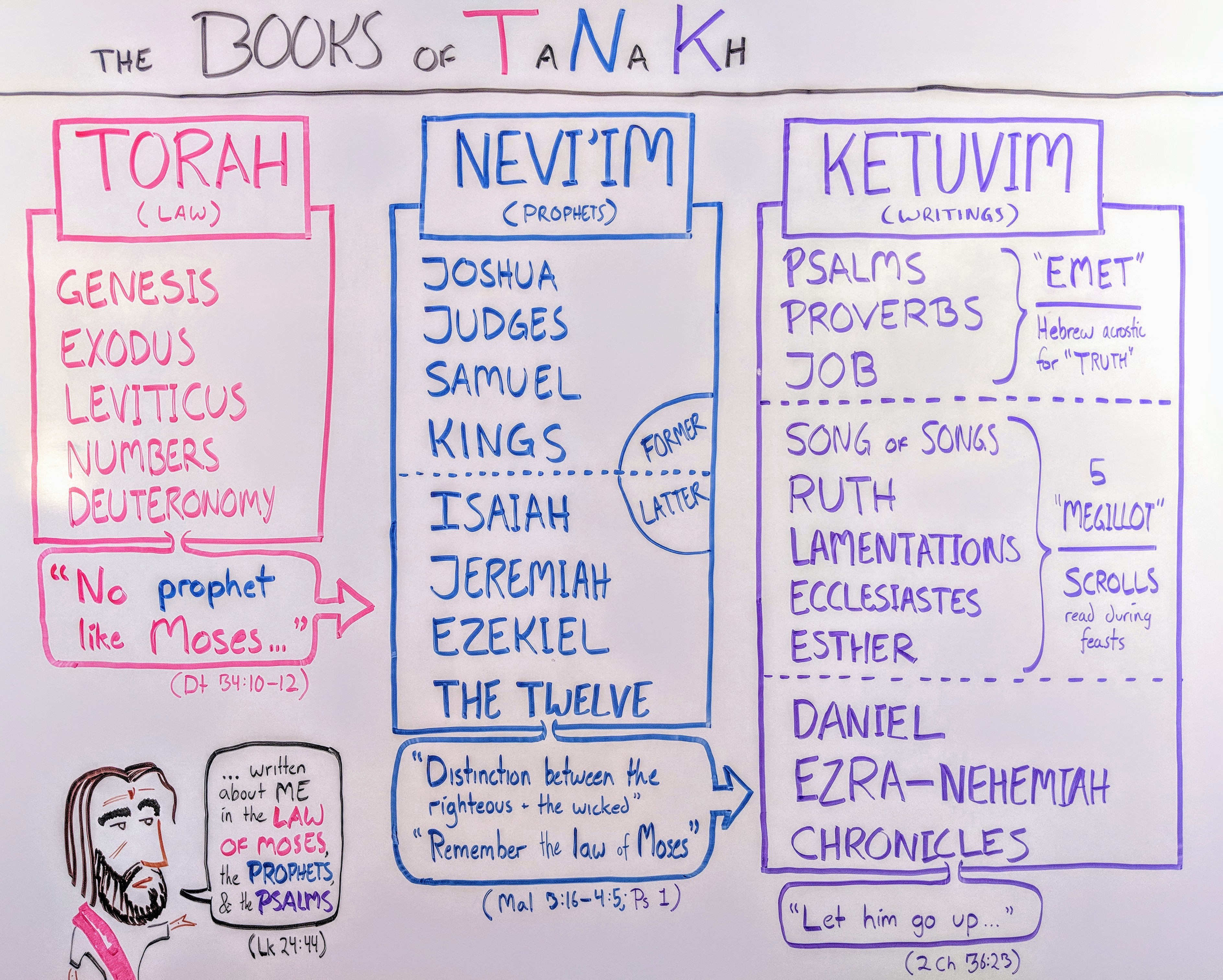To Christians, the Bible is sacred. It’s divided into two big sections: the Old Testament and the New Testament.
And a good deal of Bible geeks know that the Old Testament books are sacred to the Jewish faith, too. In fact, when Peter, Paul, and Jesus talk about “Scripture” in the New Testament, they’re referring to the books of the Old Testament—most of which had been considered sacred for a while.
But since there was no “New Testament,” (and there still isn’t in Judaism today), nobody called it the “Old Testament.” Instead, through the ages, the Rabbis have called this group of texts the Tanakh.
But there’s a twist: although the text of the Tanakh is pretty much the same as the Old Testament, the books are in a different order. The order of these books is fascinating (and quite artful).
I thought you might enjoy seeing how the Tanakh arranges these books, so I made a new video showing how they all fit together. Enjoy!
And in case you wanted to copy-paste this goodness …
The 24 books of the Tanakh, in order
Law (Torah)
These are the books of teaching, the main character of which is Moses. In these books, God chooses Israel to be his special people, and he lays out his expectations for them.
- Genesis
- Exodus
- Leviticus
- Numbers
- Deuteronomy
This section ends with the scribes commenting that no prophet like Moses has come along since his time. (Which isn’t quite true anymore, if you ask Christians!) This implies that there were more prophets—which is covered in the next section of the Tanakh.
Prophets (Nevi’im)
This is where we see God’s covenant relationship with Israel play out. (Spoiler alert: it doesn’t go so well.) God sends messengers to Israel to warn them of the consequences of breaking God’s laws, but the people, for the most part, ignore them.
- Joshua
- Judges
- Samuel
- Kings
- Isaiah
- Jeremiah
- Ezekiel
- The Twelve (Minor prophets in the OT)
The Prophets end with a note that looks back on the Torah and anticipates the writings. In the book of Malachi (which likely means, “My Messenger”), God tells the people that they will once again see the distinction between the righteous and the wicked, and urges the people to remember the law that Moses gave in the Torah.
And the Writings pick up where the Prophets left off, describing how blessed the person who remembers the Law is, and how those who forsake the law eventually come to ruin.
Writings (Ketuvim)
These works of wisdom, poetry, and narrative are arranged to help readers navigate the world in light of God’s laws. They helped ancient Jews make decisions, worship God, remember their history, and look forward to a future when the long-awaited Messiah would save them.
- Psalms
- Proverbs
- Job
- Song of Songs
- Ruth
- Lamentations
- Ecclesiastes
- Esther
- Daniel
- Ezra-Nehemiah
- Chronicles





It would be interesting to know why the order of books is changed in the Christian bible
Here is an interesting article about the order of books in the Bible, Hebrew and Christian.
https://knowingscripture.com/articles/why-we-should-use-the-hebrew-order-of-the-old-testament
Hi
regarding the 22 book Tanach – Josephus also mentions it. Early variations in Jewish thought considered Ruth as one book with Judges, and Lamentations as one book with Jeremiah (according to Jewish tradition – both share the same author)
Loving it!
Love the teaching resources very practical…Thank you Jeffrey
It always bothered me that the total number of Books in the Bible totaled 66. 39 in the Old Testament and 27 in the New Testament.) Knowing that God loves the number seven and that He often uses it as a number representing completion or perfection, made me question the total number of Books at 66.
Later, I learned that the Hebrew Bible was not arranged as it is in our English Bibles. However, the number that I had been given was 22, not 24. I do not recall the exact list to see how it differs from yours. Twenty-two makes sense because there are 22 letters in the Hebrew alphabet and we know that the Spirit used the 22 letter in Psalm 119 and the Book of Lamentations. When you take the 22 Books of the Old Testament and then add the 27 Books of the New Testament, you come up with 49, which is 7 x 7. That makes sense. The number of Books shows that the Bible we have is complete and perfect.
Have you seen the list of the Old Testament Books in twenty-two?
Hi Don—no, I’m unfamiliar with a 22-book treatment of the Tanakh (or the Christian OT, for that matter). I’ve read that Esther took a while to be adopted into the Tanakh, and that before that, Song of Songs and Ecclesiastes were the subject of a bit of rabbinic dispute.
The Tanakh book count and subdivisions instead gives plenty of attention to other biblically significant numbers, especially 3 (the patriarchs), 5 (the Torah), and 12 (the tribes of Israel). But a 49-book Christian canon would make for a neat arrangement! =)
It’s possible that some of these numbers were actually more special to the Jews than they were to God, and God used these numbers to better communicate with his people. For example, if the Jews already associated the number 7 with completion, then perhaps God’s prophets and scribes made heavy use of these numbers to help God’s people understand him better. We just don’t know—the number meaning is assumed in the Bible, but we don’t get any passages that explicitly tell us what God thinks of certain numbers.
The significance of book count in the Christian Bible is a bit less interesting to me, to be honest. We (Christians) took our sweet time finalizing the list of books we’d accept as canonical (as late as 1546 A.D. for Catholics!) and we’re not even consistent across Catholic, Orthodox, and Protestant branches of the church. Maybe it’s a side-effect of church leaders from diverse cultures weighing in on the matter, as opposed to homogenously Jewish scribes artistically crafting the Tanakh.
BUT if you’re itching for some sevens, consider this: the book of Psalms is actually five books in one (a nice reference to the Torah). So you could say that the Christian Bible has seventy books: 66 books – 1 (Psalms proper) + 5 (the five books of Psalms) = 70. So it’s not too far off to say that the canon, as it is, is a nice round 70. ;-)
Someday I’ll do a video or course on numbers in the Bible. I think that’d be a great way to appreciate the intricacies of the Bible—it really is a work of art.
Jeffrey,
Thanks for your reply. Sometimes seven is significant and sometimes it is not.
One of my websites is: sevens in the bible dot com
Josephus, apparently groups Judges-Ruth and Jeremiah-Lamentations together as well as the other TaNakh listings. Hence the 22. I discovered this while reading Robert Plummer’s 40 Questions About Interpreting the Bible.
Hi
Actually, Josephus mentions that the Tanakh has 22 books – he combines Judges and Ruth into one book (Dr Yael Ziegler’s work on Ruth discusses many of the connections between them) and Jeremiah and Lamentations into one book (Jewish tradition identifies Jeremiah as the author of Lamentations)
All the best!
As an adult Bible teacher in my church for the past 40 years, I am very much enjoying your videos on the Bible and filing them away for future reference. Keep them coming. You are doing a great job!
Thanks for the kind words, David—I’m glad to hear these are helpful. =)
Really appreciated the research & easy to read and understand format.
Great work! So interesting, thank you again.
Thanks, Roselani—glad it’s helpful.
Loving your videos. Thank you. We will be showing them to our students of the Bible here in Ugandan villages. Such a blessing.
Thank you, Susan—I’d love to hear if your friends in Uganda find them helpful. =)
Jeffery,
I was so looking forward to your Whiteboard Bible Study on Tanakh because your previous Whiteboard Bible Study presentations would be captioned. However, this time, the Tanakh video isn’t captioned. :'( Will y’all be able to get it captioned someday? I will read the “transcript” below your video.
Brent
Hi, Brent! For whatever sad reason, YouTube’s auto-captioning isn’t kicking into gear on this video. Apologies for the inconvenience!
I loved the video. Have never had the books of the Old Testament explained in that way.
Thanks, Janet. Isn’t it fascinating?
Hi Jeffrey, I’ve recently purchased your latest book “Bible for beginners” and while I’m an old and ageing Xn I’m sure I will find it an invaluable evangelistic tool so thank you. In taking note of the order and grouping of the Tanakh, Do you feel a reader of the Hebrew Bible through Xn eyes would bring a different perspective to the meta narrative of the Xn Bible?
Thanks for the kind words, Hamish!
That’s a difficult question to answer, since there’s no telling what the “former” perspective is, and there are so many perspectives that people bring to the Bible (Hebrew, Greek, Latin, English, whatever) that fall under the Christian label. I think the general Christian narrative of Scripture comes through regardless of the way you order the OT—but that’s mostly because so much of the big points of the OT’s story is interpreted for us (to some degree) by the NT anyway.
There’s always more to learn, for sure. And it’s preferable to understand the contexts of the Bible’s authors, editors, and original readers. But fortunately the big stuff is pretty straightforward and timeless. =)
Very interesting…thank you. Jesus said that all of the Tanakh testified of Him. It would be a good study to see all those, too.
Psalm 22 is one, I believe.
I’m reading Exodus presently and realize that the priests had to have the clothing on and then I thought where the apostle Paul said…Christians are to ‘put on’ the Lord Jesus Christ’ and put off other things.